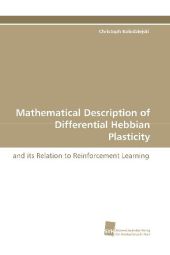 Neuerscheinungen 2010Stand: 2020-01-07 |
Schnellsuche
ISBN/Stichwort/Autor
|
Herderstraße 10
10625 Berlin
Tel.: 030 315 714 16
Fax 030 315 714 14
info@buchspektrum.de |

Christoph Kolodziejski
Mathematical Description of Differential Hebbian Plasticity
and its Relation to Reinforcement Learning
2010. 156 S. 220 mm
Verlag/Jahr: SÜDWESTDEUTSCHER VERLAG FÜR HOCHSCHULSCHRIFTEN 2010
ISBN: 3-8381-1372-1 (3838113721)
Neue ISBN: 978-3-8381-1372-2 (9783838113722)
Preis und Lieferzeit: Bitte klicken
The human brain consists of more than a billion nerve cells, the neurons, each having several thousand connections, the synapses. These connections are not fixed but change all the time. In order to describe synaptic plasticity, different mathematical rules have been proposed most of which follow Hebb´s postulate. Donald Hebb suggested in 1949 that synapses change if pre-synaptic activity, i.e. the activity of a synapse that converges to the neuron, and post-synaptic activity, i.e. activity of the neuron itself, correlate with each other. A general descriptive framework, however, is yet missing. With the results developed here, it is now possible to relate different Hebbian rules and their properties to each other. Additionally, a setup is presented with which any Hebbian plasticity rule with a certain property can be used to emulate temporal difference learning, a widely used reinforcement learning algorithm. Further on, it is also possible to calculate plasticity analytically for many synapses with continuously changing activity. This is of relevance for all behaving systems (machines, animals) whose interaction with their environment leads to widely varying neural activation.
From 2005 on the author did research as Ph.D. student andafterwards as postdoc in the area of theoretical andcomputational neuroscience at the Bernstein Center for Computational Neuroscience at the University of Göttingen, withspecial focus on synaptic plasticity and reinforcement learning.


